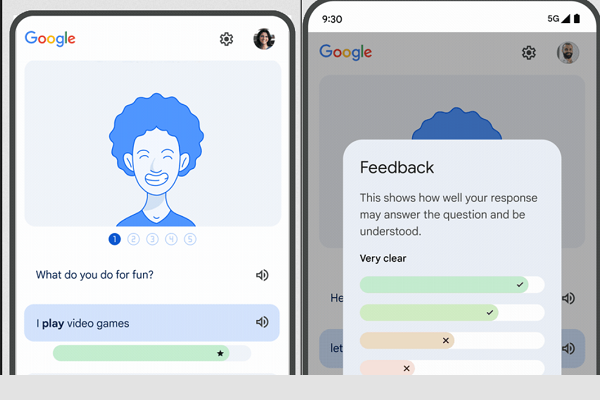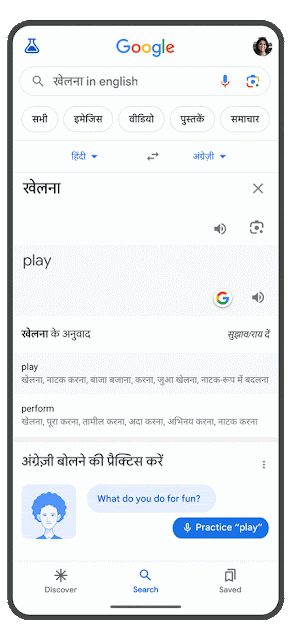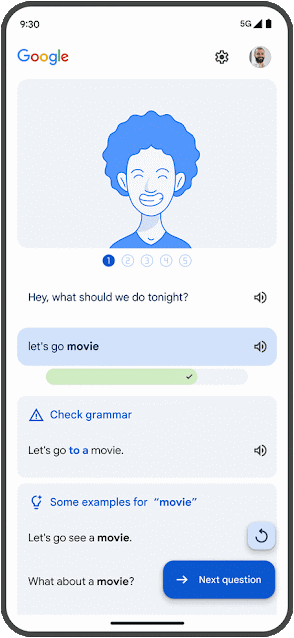Google Search Rolls Out AI-Powered Speaking Practice for Language Learners
 Google has introduced a new feature in its search engine that provides interactive speaking practice to help people improve their language skills. Android users in six countries can now access AI-enabled tools for learning English, with additional languages to follow. The feature allows users who are translating between English and their native tongue to practice speaking the words and phrases in context. They are given real-life conversational prompts and form spoken answers using target vocabulary, similar in some ways to how Duolingo teaches new languages.
Google has introduced a new feature in its search engine that provides interactive speaking practice to help people improve their language skills. Android users in six countries can now access AI-enabled tools for learning English, with additional languages to follow. The feature allows users who are translating between English and their native tongue to practice speaking the words and phrases in context. They are given real-life conversational prompts and form spoken answers using target vocabulary, similar in some ways to how Duolingo teaches new languages.
Google Search Linguistic Learning
Learners do a three to five-minute session and receive personalized guidance on how they are performing in order to continue improving their language skills by smartphone. Google designed the practice to supplement other learning resources like apps, tutoring, and classes. Partnering with linguists and pedagogical experts, it aims to give motivating opportunities to become confident speakers. The feature provides vocabulary reinforcement in authentic situations, an approach known to boost retention. A key component is personalized real-time feedback. A deep learning model analyzes audio responses to provide helpful corrections and suggestions.
“Google Search is already a valuable tool for language learners, providing translations, definitions, and other resources to improve vocabulary. Now, learners translating to or from English on their Android phones will find a new English speaking practice experience with personalized feedback,” Google Research director Christian Plagemann and produce manager Katya Cox explained in a blog post. “Every learner is different, so delivering personalized feedback in real time is a key part of effective practice. Responses are analyzed to provide helpful, real-time suggestions and corrections. The system gives semantic feedback, indicating whether their response was relevant to the question and may be understood by a conversation partner. Grammar feedback provides insights into possible grammatical improvements, and a set of example answers at varying levels of language complexity give concrete suggestions for alternative ways to respond in this context.”
 For grammar help, Google adapted models for correcting written language to handle spoken speech transcriptions. Fine-tuning on a corpus of human and computer-generated transcripts significantly boosted correction rates compared to models trained only on text. The speaking practice also utilizes AI to develop some instructional content and tasks, which experts then review. This includes prompts, vocabulary lists, and example conversational responses. Google trained new machine learning models to estimate the complexity levels of individual words, phrases, and sentences. This tailors activities and suggestions to each learner’s abilities, challenging them appropriately as they progress.
For grammar help, Google adapted models for correcting written language to handle spoken speech transcriptions. Fine-tuning on a corpus of human and computer-generated transcripts significantly boosted correction rates compared to models trained only on text. The speaking practice also utilizes AI to develop some instructional content and tasks, which experts then review. This includes prompts, vocabulary lists, and example conversational responses. Google trained new machine learning models to estimate the complexity levels of individual words, phrases, and sentences. This tailors activities and suggestions to each learner’s abilities, challenging them appropriately as they progress.
To make language learning more practical, Google developed new contextual translation technology to enable tapping individual words for definitions considering the surrounding context. This helps learners understand unfamiliar terms that have multiple meanings in isolation. Google claims it reaches state-of-the-art accuracy, enhancing services like Chrome webpage translation.
“The key technology piece that enables this functionality is a novel deep learning model developed in collaboration with the Google Translate team, called Deep Aligner,” the researchers wrote. “The basic idea is to take a multilingual language model trained on hundreds of languages, then fine-tune a novel alignment model on a set of word alignment examples (see the figure above for an example) provided by human experts, for several language pairs.”
Search AI
Google’s speaking practice sets the stage for Search to evolve into a personalized AI tutor, not just an information repository. The same technology could potentially expand into teaching other subjects over time. For now, Google is focused on empowering language learners to become proficient speakers and build connections worldwide. But there a lot of possibilities if the search morphs into a master AI educator.
Google Search has been steadily enhancing its features with AI this year. Most recently, Google augmented its search responses with generative AI into its results, producing images and text from search queries. The text-to-image tool responds within the search results, and users can refine descriptions to edit images and add more details before exporting. That option came after Google Search added generative AI features like enhanced definitions, code explanations, and webpage summaries. Embedding synthetic media tools within Search is a much bigger step. It’s more akin to how Google is melding its Bard generative AI with Google Assistant to create a multimodal Assistant with Bard.
Follow @voicebotai Follow @erichschwartz
Google Bard Enhances Model With Answers from Your Gmail, Docs, and More Apps








